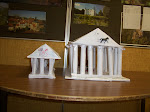Mythology Paper
Your task: W rite a standard expository essay using formal voice and all appropriate conventions of writing. Your paper will have
Introduction—With Background Info, Thesis and POA
2 Body Paragraphs—correctly formatted
Conclusion
Topic/Thesis: The ancient Greeks used Mythology to help explain the natural world around them.
Below is some information about your full expos paper that you are writing. I do not have our brainstormed list of stories available to post online, but hopefully the following information is still helpful for giving you a sense of what the essay should be like.
Your task: W rite a standard expository essay using formal voice and all appropriate conventions of writing. Your paper will have
Introduction—With Background Info, Thesis and POA
2 Body Paragraphs—correctly formatted
Conclusion
Topic/Thesis: The ancient Greeks used Mythology to help explain the natural world around them.
Support/POA: You will need to choose three categories to use for your 2 support paragraphs. You may choose from the following list, or create your own.
Flowers
Trees/Plants
Animals: Appearance, existence, behavior
Geographical locations/names
Seasons
Weather events
Mankind: existence and behaviors
Stars/Constellations/Heavenly events
Note: Each support you choose will be developed into a body paragraph. You must then have three myths that will explain each support point and connect back to the thesis. You must find a balance for the description you provide of each myth. Embrace the ideal of the Golden Mean—too much information will get off topic, and too little information will be unacceptably brief!
Warning: Make sure you are using your own words! The ghost of Edith will haunt you if you steal her words without giving her credit. (You’ll lose credit also)
Body Paragraph Format:
Topic sentence: Introduces support point and connects back to thesis
Transition+ Supporting Myth #1—Brief summary and explanation
Transition + Supporting Myth #2—Brief summary and explanation
Transition + Supporting Myth #3—Brief summary and explanation
Summary sentence connecting back to topic of paragraph and thesi
Tuesday, December 3, 2013
Subscribe to:
Posts (Atom)

